Top 10 Cuisines in Nanjing
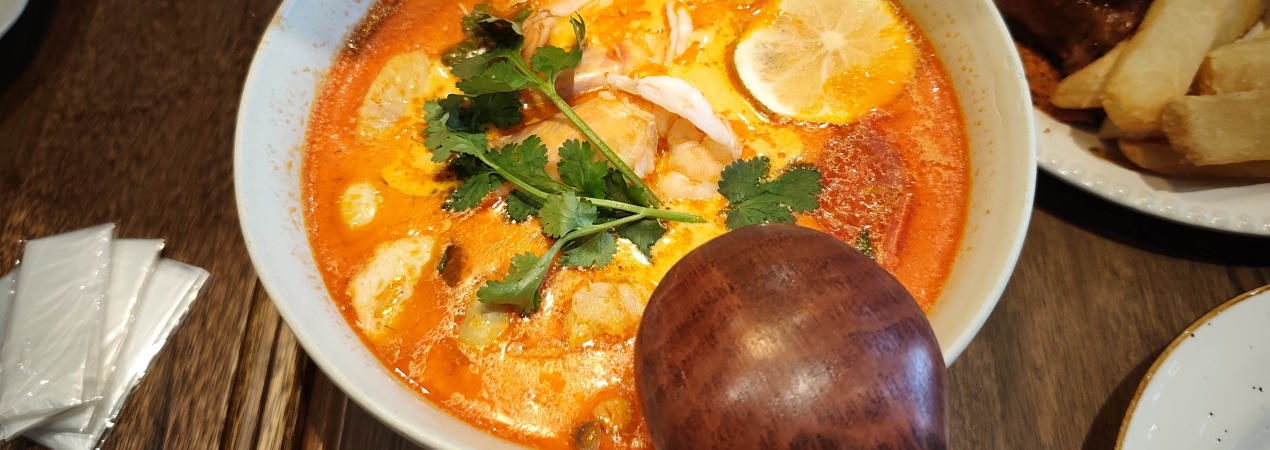
Nanjing’s top ten dishes have great craftsmanship—they range from the famous Braised Salted Duck (a 2,500-year-old treat) to the fancy Palace Lantern Prawns, which took ideas from Republican-era lanterns. At New Year, you can enjoy crispy Five-Spice Fish, plus Pounded Eel that melts in your mouth, and the meaningful “Ten-Ingredient Delight.” Every dish mixes history, skill and good-luck meanings. In China’s “Duck Capital,” these dishes are a real joy for your senses.
Braised Salted Duck
 Braised Salted Duck
Braised Salted Duck
There's a common saying among Nanjing locals: "No feast is complete without duck." As the "golden signature" of this "Duck Capital," braised salted duck has a history going back to the Spring and Autumn and Warring States periods. To make it, a 12-character rule is followed: "marinate with cooked salt, re-soak in clear brine, air-dry thoroughly, and simmer well."
As white and smooth as congealed fat, the duck skin pairs with meat that's firm but not tough. A rich, salty flavor goes deep into the bones—even the bones taste good. You can also find a subtle sweet hint with the salty umami. Out-of-town tourists must try this specialty, and it's also a regular dish on Nanjing people's dining tables.
Recommendation: Jinling Duck House (near Fuzimiao)
How to get there: Take Metro Line 3 to Fuzimiao Station, Exit 5, then walk 300 meters north.
Phoenix-Tailed Shrimp
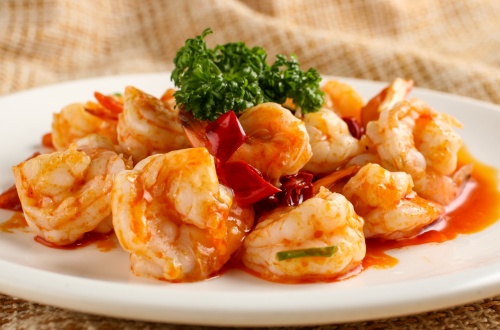 Phoenix-Tailed Shrimp
Phoenix-Tailed Shrimp
For this dish, people use fresh large river shrimp, and big green shrimp work best. First, you take off their heads and body shells—keep the tail shells on—then remove the red veins and coat the shrimp with starch paste. After that, you stir-fry them with green peas, diced dried mushrooms, diced bamboo shoots and white scallion sections in duck oil.
Once the shrimp go into the wok, they look nice with red and white mixed, and they're very attractive. It's one of the well-known "Four Famous Dishes" at home and abroad; the shrimp meat is tender and fresh. What's more, the smell of duck oil adds a unique flavor to the shrimp.
Recommendation: Liuhua Chun Restaurant (Confucius Temple Area)
How to get there: Take Bus No. 1 or 4 to Confucius Temple South Station, then walk 200 meters east.
Braised "Sheng Qiao" (Pounded Eel)
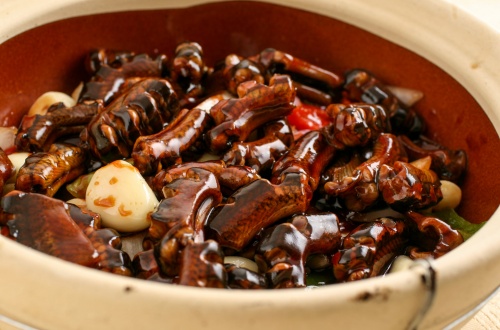 Braised "Sheng Qiao"
Braised "Sheng Qiao"
"Sheng Qiao" is a time-honored Nanjing dish with over 300 years of history. It gets the name from the technique: you debone the eel first, then pound it with a wooden mallet to make the meat tender. After that, the eel is braised with garlic and seasonings until it's tender.
The dish has glossy white skin and meat with a pink tint. It tastes savory and well-balanced, plus it's fragrant, fresh and tender enough to melt in your mouth. Scholar Wu Baitao once wrote a verse to praise it: "For rich aroma and depth of taste, Nanjing's Braised Sheng Qiao reigns supreme."
Recommendation: Laobai Snack Bar (Near Xinjiekou)
How to get there: Take Metro Line 1 or 2 to Xinjiekou Station, Exit 8, then walk 400 meters west.
Five-Spice Smoked Fish
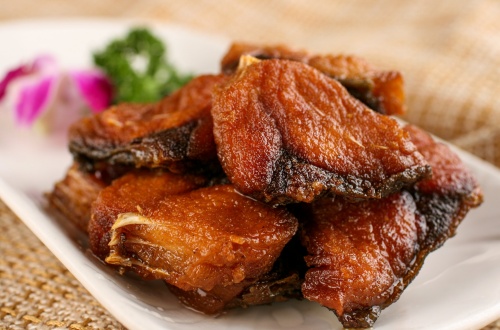 Five-Spice Smoked Fish
Five-Spice Smoked FishFive-spice smoked fish always appears on Nanjing families' dining tables during the New Year. Cut the fish into pieces first, fry them until they turn golden, then soak them in spiced sauce—this gives the fish a glossy amber coating. The fish is crispy outside and tender inside, and it soaks up the sweet but savory sauce. It tastes rich and lingers on the palate, and it's a traditional festive food in Nanjing.
Recommendation: Nanjing Folk Cuisine Restaurant (Gulou District)
How to get there: Take Bus No. 31 to Gulou Square Station, then walk 250 meters south.
Jinling Meatballs
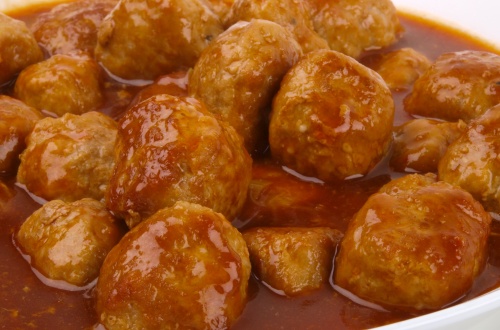 Jinling Meatballs
Jinling MeatballsThis classic Nanjing dish, part of Jiangsu-style cuisine, uses finely minced good pork, mixed with chopped dried shrimp and seasonings. Shape the mix into balls, coat them lightly with starch, pan-fry till golden, then braise in a clay pot with soaked tendons for two hours. The meatballs turn melt-in-your-mouth, sitting in a rich, fragrant broth, and the tender tendons go well with them—it's a fancy dish that shows Nanjing's cooking tradition.
Recommendation: Jiangsu Cuisine Garden (Hexi New Town)
How to get there: Take Metro Line 10 to Hexi Sports Center Station, Exit 3, then walk 500 meters north.
Yipin Quanjiafu (Imperial Family Stew)
This fancy dish mixes good ingredients—sea cucumber, abalone, fish maw, fish balls and egg dumplings. Simmer them with fresh vegetables in a rich, tasty broth. Its name "Quanjiafu" means "Family Blessing" and stands for harmony, so it's the main dish at reunions. The mix of textures and balanced nutrition shows what shared meals are about in Chinese food culture.
Recommendation: Haojing Seafood Restaurant (Qinhuai District)
How to get there: Take Metro Line 5 to Qinhuai River East Station, Exit 2, then walk 350 meters east.
Babao Huangmen Duck (Eight-Treasure Braised Duck)
This dish was an imperial delicacy from the Ming Dynasty. A duck is stuffed with glutinous rice, lotus seeds, ham, dried scallops and other good things, then slow-braised in a clay pot to lock in flavors. When the duck gets tender enough that meat falls off the bone, its fragrant filling shows up—it's a savory mix with a little lotus leaf smell. People often call it "Jiangnan's version of Buddha Jumps Over the Wall." This complex, rich-tasting dish shows traditional good cooking skills.
Recommendation: Ming Dynasty Imperial Cuisine (Zhongshan Scenic Area)
How to get there: Take Bus No. 20 to Zhongshan Mausoleum East Station, then walk 450 meters west.
Palace Lantern Phoenix-Tail Prawns
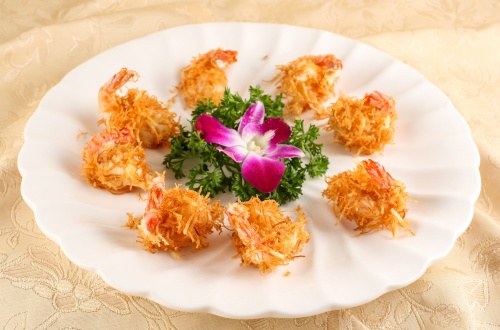 Palace Lantern Phoenix-Tail Prawns
Palace Lantern Phoenix-Tail PrawnsDuring the Republican era, this dish was born from a chef at Nanjing's "Liu Huachun" restaurant—near the Confucius Temple—who took inspiration from palace lanterns. First, you take prawns: shell them, but keep their tails, then cover them with egg white and starch. After that, deep-fry them until they're golden and curl a bit. The tails look like lantern tassels, while the bodies get translucent, just like thin gauze. A carved pumpkin acts as the base for the dish. It's six-sided (like a lantern) and holds a secret tomato sauce—you dip the prawns in this. The sauce's tangy sweetness makes the prawns' natural taste pop. This dish was well-known for its nice look and flavor, and Madame Soong May-ling often served it to guests as her go-to dish.
Recommendation: Liu Huachun Restaurant (Confucius Temple Pedestrian Street)
How to get there: Take Metro Line 3 to Confucius Temple Station, Exit 4, then walk 150 meters along the pedestrian street.
Xiangxing Squirrel Fish
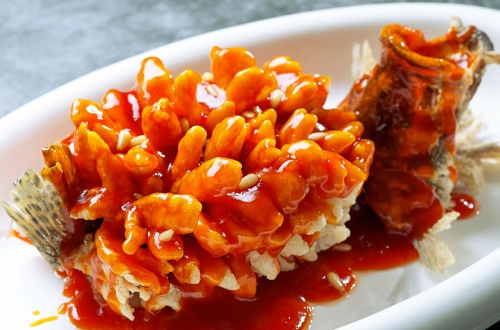 Xiangxing Squirrel
Xiangxing SquirrelNanjing's Xiangxing Squirrel Fish is different from the Suzhou-style one that uses mandarin fish—it uses Yangtze mullet instead. The fish is scored, then fried with its head up and tail curled, so it looks like it's leaping. The fish turns golden and crispy; people pour sweet-and-sour sauce (with plum wine in it) over it, then add pine nuts and diced green plums as garnish. The sauce's tangy fruit taste goes well with the fish's crispy texture, and the fun “squirrel” shape is nice to look at. There's a legend: late Qing painter Fu Baoshi once asked for the dish to be served like a “Carp Leaping Through the Dragon Gate” scene.
Recommendation: Jinling Seafood Restaurant (Hunan Road Pedestrian Street)
How to get there: Take Metro Line 1 to Hunan Road Station, Exit 1, then walk 200 meters south.
Vegetable Medley
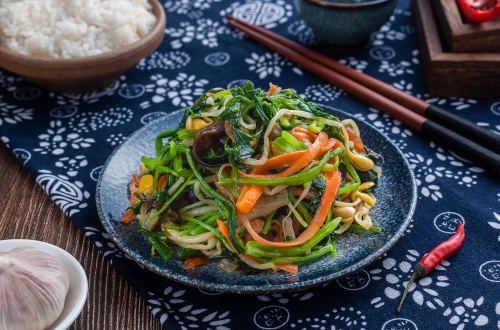 Vegetable Medley
Vegetable Medley In Nanjing, this is a classic New Year's dish—people also classic New Year's dish—people also call it “Ten-Ingredient Delight,” and it stands for perfection and prosperity. To make it, you stir-fry ten chosen veggies, like carrots, soybean sprouts, celery, wood ear mushrooms and bamboo shoots. Each veggie is cut into the same size so it cooks evenly. The dish has a bright green color, a fresh crunch and a light smell. It's healthy (with balanced nutrients) and brings good luck too. On Nanjing's festive tables, this tasty, healthy dish is always a favorite.
Recommendation: Qingqing Vegetarian Restaurant (Xinjiekou Business District)
How to get there: Take Metro Line 1 or 2 to Xinjiekou Station, Exit 6, then walk 300 meters north.
Drop us a line and we'll connect you with the top China expert in no time!